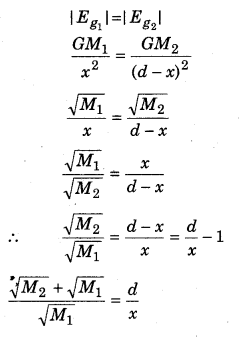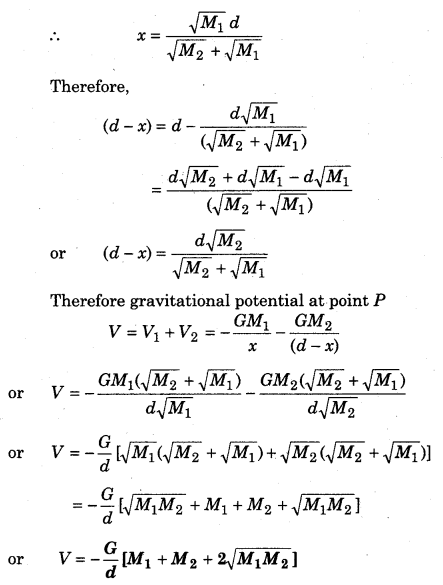Rajasthan Board RBSE Class 11 Physics Chapter 6 Gravitation
RBSE Class 11 Physics Chapter 6 Textbook Exercises with Solutions
RBSE Class 11 Physics Chapter 6 Very Short Answer Type Questions
Question 1.
Weightlessness is experienced in artificial satellite but why not on the Moon?
Answer:
Weightlessness is not experienced on the Moon because due to its greater mass it has its own gravitational acceleration where as gravitational acceleration on artificial satellite is negligible.
Question 2.
How much energy is required by a satellite to revolve in its orbit?
Answer:
Since, work done by the centripetal force is zero. Hence, no energy is required.
Question 3.
If Earth is a hollow sphere; then what would be the mass of an object at a depth 10 km below the Earth’s surface?
Answer:
The value of g is equal to zero in a hollow sphere, hence, the weight (mg) will also be zero.
Question 4.
Why are high tides and low tides in the sea?
Answer:
Due to gravitational effect of Moon there is high tides and low tides in the sea.
Question 5.
Why is the Earth fiat at the poles?
Answer:
Due to rotation of Earth about is own axis, the Earth is flat at the poles.
Question 6.
If the Earth revolves around the Sun in circular orbit then what would be the work done by the gravitational force?
Answer:
Gravitational force provides the necessary centripetal force, which at right angles to motion of the Earth, so by the relation W = Ed cos θ
∴ W = Fd cos 90 = 0
hence no work is done by gravitational force.
Question 7.
How many Newtons are there in 1 kg weight?
Answer:
∵ W = mg, ∴ 1 kg weight = 1 × g = 1 × 9.8 = 9.8 N
Question 8.
The value of escape velocity for any object from the surface of the Earth is 11.2 km/s. If the object is thrown at an angle of 30° then what would be the value of escape velocity?
Answer:
Since the escape velocity does not depend upon the angle of projection, hence the escape velocity will be same.
Question 9.
Moon is very light in comparison to the Earth. Then why does not it fall down due to Earth’s gravitation?
Answer:
Earth’s gravitational force is normal to motion of Moon, therefore work done is zero. Hence the Moon does not fall due to Earth’s gravitation.
Question 10.
The weight of 10 g gold is more at the poles in comparison to the equator. Why?
Answer:
Weight of an object, W = mg. The value of g is maximum at poles and minimum at equator by the relation g = \(\frac{G M}{R^{2}}\) This is why the weight of 10 gram gold is greater at poles than at equator.
Question 11.
Name the first satellite launched by India.
Answer:
Aryabhatta; 19th April, 1975.
Question 12.
Give the dimensional formula of gravitational potential.
Answer:
Intensity of gravitational field,
Eg = \(\frac{F}{m}\)
Dimensional formula of Eg = \(\frac{\left[\mathrm{M}^{1} \mathrm{L}^{1} \mathrm{T}^{-2}\right]}{\left[\mathrm{M}^{1}\right]}\)
= [M0LT-2].
RBSE Class 11 Physics Chapter 6 Short Answer Type Questions
Question 1.
Give differences between weight and mass.
Answer:
Mass : The mass of an object tells, how much quantity of substance is there in the object. Measurement of mass is done with the help of physical balance in unit of kg.
Weight : The weight of an object is the force by which Earth attracts the object towards its centre. It is force and its value is obtained by mg where m is the mass of the object and g is the acceleration due to gravity at the location of the object. The measurement of the weight is done by spring balance.
On changing the place on the Earth, the mass remains unchanged while the weight varies according to change in the value of ‘g’.
Question 2.
If during revolving around the Earth’s orbit, the mass of a satellite is doubled due to any reason, then what would be the effect on time period?
Answer:
The time period of the satellite,
T = \(2 \pi \sqrt{\frac{r^{3}}{G M}}\)
where, r = radius of the orbit,
M mass of Earth.
In above formula the mass of the satellite (m) is not used. Therefore the time period T will not depend on m. Hence, on doubling the mass of the satellite, its time period will remain unchanged.
Question 3.
Can any artificial satellite be placed at any orbit so that it seen always above Rajasthan’s capital Jaipur? Explain clearly.
Answer:
A satellite can be seen always only in the orbit above the equator and Jaipur does not lie in equatorial plane. Therefore such an artificial satellite is not possible which may always be seen above Jaipur.
Question 4.
Generally why are rockets launched at the equator surface from west to east?
Answer:
The direction of rotation of Earth is from west to east. Therefore the rockets are also launched in this direction so that they may take the place of geostationary satellite. The rockets are launched on equator surface because they may be geo-station only in this plane. The reason of launching the rockets from west to east is to minimise the consumption of fuel because by this action, the relative velocity of the rocket = velocity of rocket + velocity of earth.
Thus, the velocity of rocket increases resulting the less consumption of fuel.
Question 5.
If a watch based on the simple pendulum is kept at the center of the Earth, then what would be its time period? Will the watch work?
Answer:
The value of acceleration due to gravity at the depth of d below Earth’s surface,
g’ = \(g\left(1-\frac{d}{R}\right)\)
where g is the acceleration due to gravity at Earth’s surface and R is it’s radius.
For the centre of the earth,
d = R
∴ g’ = \(g\left(1-\frac{R}{R}\right)\) = g (1 – 1)
or g’ = 0
∴ The time period of simple pendulum.
T = \(2 \pi \sqrt{\frac{l}{g^{\prime}}}=2 \pi \sqrt{\frac{l}{0}}\) = ∞ (infinity)
Thus the time period of the watch based on simple pendulum will be infinite i.e., the watch will not work.
Question 6.
Due to the greenhouse effect if the ice at the poles will melt, then what would be the effect on the duration of the day on Earth?
Answer:
On melting the ice will convert into water which moves away from axis of rotation. Therefore the moment of inertia increases. As a result, the angular velocity of rotation of Earth decrease and hence the Earth will take more time to complete the rotation. Hence the duration of the day will increase.
Question 7.
Different countries establish different communication satellites in the orbits for their communication system. Are these orbits different? Explain.
Answer:
The time period of each geo-stationary satellite revolving the Earth is 24 hrs and the height of this orbit from the surface of Earth is 3600 km. Therefore each country requires its own geo-stationary satellite for its communication system. Thus it is clear that the communication satellites of each country are in the’same orbit but in different situations.
Question 8.
If the Earth stops rotation on its axis, then what would be the change in the value of gravitational acceleration at equator and poles?
Answer:
The value of gravitational acceleration (in latitude),
g’ = g – ω2Rcos2 λ
(i) For poles, λ = 90°, ∴ cos2 λ = 0
Therefore g’ = g
Therefore, even the Earth stops its rotation, i.e, ω = 0, there will be no change in gravitational acceleration.
(ii) For equator, λ = 0. ∴ cos λ = 1
If ω = 0 i.e., Earth stops rotation, then
g’ = g
Thus the value of gravitational acceleration increase on the equator when Earth stops it’s rotation.
Question 9.
Are there some celestial bodies for which the value of acceleration due to gravity is infinity?
Answer:
Acceleration due to gravity for celestial body
where g = \(\frac{G M}{R^{2}}\)
M = the mass of the body
R = the radius of the body
Therefore, for g to be infinity,
(i) The value of M should be infinite
(ii) The radius R should be zero.
Above both the conditions are not possible for a real body. Therefore such a celestial body is not possible on which the value of gbe infinite.
Question 10.
A satellite revolves around a planet in elliptical orbit. If F is gravitational force then what would be the central force?
Answer:
For satellite,
Required centripetal force = Gravitational attraction between planet and satellite.
or Fc – Fg
This gravitational force will be the central force.
Question 11.
Define gravitational potential and give its units in S.I.
Answer:
Gravitational potential : Gravitational potential at any point in the gravitational field is equal to work done in bringing unit mass from infinity to that point. It is represented by VG .
∴ VG = \(\frac{W}{M}\)
Where W = the work done in bringing mass M from infinity to that point
∴ S.I. unit of VG = \(\frac{J}{\mathrm{kg}}\) = J. kg-1
Question 12.
If due to any reason the kinetic energy of a satellite increases 100% then what would be its behaviour?
Answer:
The kinetic energy of the satellite,
K = \(\frac{1}{2} \frac{G M m}{r}\)
If the kinetic energy is increased by 100%, then

Therefore, the binding energy of the satellite in this new situation
Et = K’ + U = \(\frac{G M m}{r}-\frac{G M m}{r}\) = 0
or Et = 0
Therefore the satellite will escape.
RBSE Class 11 Physics Chapter 6 Long Answer Type Questions
Question 1.
Derive the formulae for kinetic energy and binding energy of a satellite.
Answer:
Energy of a Satellite
When the satellite is revoling in its orbit it has kinetic energy due to the orbital velocity and due to its position it has potential energy. The sum of these two types of energies in an orbit is the total energy of the satellite.
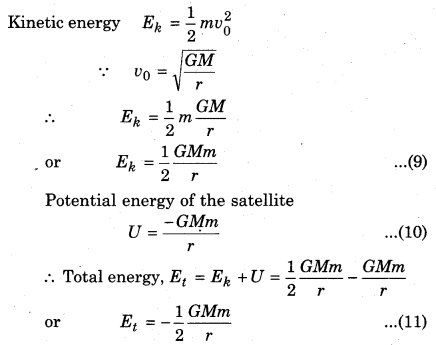
It is clear that the total energy is negative which means that the satellite is an attached body to the planet. To free it we require external energy.
Binding Energy of a Satellite
“The minimum amount of energy required for a satellite by which it can leave out its orbit or escape from the gravitational influence is called the binding energy of a satellite”. It is represented by Eb.
Total energy of the satellite, Et = \(-\frac{1}{2} \frac{G M m}{r}\)
When the satellite escapes at infinity its total energy will be zero. Hence binding energy of the satellite
Eb = Eb – Et = 0 – \(\left[-\frac{1}{2} \frac{G M m}{r}\right]\)
or Eb = \(\frac{1}{2} \frac{G M m}{r}\)
Question 2.
Write about the contributions of Indian astronomers.
Answer:
Dr. Vikram Sarabhai is known as the father of Indian Space Programme. ISRO (Indian Space Research Organisation) is for higher level space research programmes. Indian Space Research Organisation was established in the year 1969 on 15th August. Indian space research journey is very long and significant; which can be described from first satellite Aryabhata (1975) to the present Mangalyaan (2013). Indian Astrophysicist Dr. Subrahmanyam Chandrashekhar was awarded Nobel prize in the year 1983 for Chandrashekhar Limit.
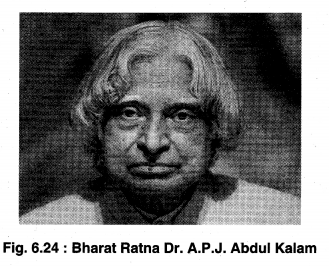
According to this, mass of all the White Dwarfs stars is in the limit given by Chandrashekhar Limit. If the mass of a star becomes 1.44 times the mass of the Sun then it will become a Black hole. In his honour, NASA (National Aeronautics and Space Administration) established an X-ray laboratory dedicated to the study of stars in the year 1999.
Principles of Dr. C.V. Raman and Shri Meghnad were also useful in spaceworks. Shri Vikram Sarabhai established Physical Research Laboratory in Ahemedabad.
India’s first satellite was made by ISRO, which was launched by Soviet Union on 19th April 1975. Rohini satellite was launched by Indian launching I vehicle SLV-3 in the year 1980 from Sriharikota. This was first launch by India. In the year 2014 a heavy satellite GSAT-14 was projected in its orbit by GSLV-D5. ISRO constructed Indian cryogenic engine for this. After this first successful flight India has become the sixth country to have this technique in the world. After this GSAT-6 vehicle was successfully launched on 27th August 2015 by GSLV-D6. On July 2012, former President of India and ‘Missile Man’ Dr. A.P.J. Abdul Kalam said that ISRO and DRDO work for making the space techniques less expensive and more efficient. This is the reason that Mangalyaan’s successful launching was less expensive than the hollywood film ‘Gravity.’
Indian Space Research achievements are as following :
1. In the year 1963, India launched its first rocket from Thumba.
2. In the year 1967, an Experimental Satellite Communication Earth Station was established at Ahmedabad.
3. For various space researches Indian Space Commission and Department of Space was established in the year 1972.
4. On 19th April, 1975 first satellite was launched in the name of great scientist Aryabhatta.
5. Bhaskar-1 was launched in the year 1989.
6. In the year 1981 communication satellite named Apple was launched.
7. INSAT-lA (Indian National Satellite) was launched in the year 1982.
8. INSAT-1B was launched in the year 1983.
9. Shri Rakesh Sharma was the first Astronaut of India in the year 1984.
10. India’s first operational remote sensing satellite was launched in the year 1988.
11. INSAT-ID was launched in the year 1990.
12. INSAT-2C was launched in the year 1995.
13. INSAT-2D was not launched successfully in June 1997, but in September, 1997 IRS-1D was successfully launched.
14. GSLV-D1 was partly successful in the year 2001.
15. In the year 2004, GSLV-EDUSAT was successfully launched.
16. On 22nd October, 2008 Chandrayaan-1 was successfully launched.
17. On 5th November, 2013 Mangalyaan was successfully launched.
18. On 24th September, 2014 Mangalyaan (298 days after launching) successfully established itself in the orbit of Mars.
19. On 5th January, 2014 GSLV-D5 was successfully launched.
20. On 18th December, 2014 the flight of GSLV-MKIII was successful.
21. On 28th September, 2015 India’s first dedicated multi-wavelength space observatory was launched named ‘Astrosat.’
Main Achievements of the Century
Chandrayaan-l made an important discovery by discovering the presence of water molecules on the Lunar surface.
Chandrayaan-1 was sent on 22nd October, 2008 on the Moon. It was launched by PSLV-Cll from Satish Dhawan Space Center.
Its main objective was to discover water and He gas. For this achievement India has become the sixth country in the world. After its disconnection from the orbit it was closed. According to ISRO’s Head Shri Madhwan Nayar on 30th August 2009 ISRO closed Chandrayaan-1 officially.
According to Times Magazine Mangalyaan was selected in the list of Best Inventions in the year 2014. Mangalyaan’s successful launch was the showcase of Indian scientists talent which establishes themselves in the whole world.
Mangalyaan, Mass Orbitter Mission (MOM) was launched on 5th November, 2013 by ISRO from Shriharikota (Andhra Pradesh).
On 24th September, 2014 India was the first country to reach on Mars in its first attempt. This is a great achievement of Indian scientists and reseaschers.
Question 3.
What do you mean by orbital velocity and escape velocity? Give formulae and relationship for these.
Answer:
Escape Velocity
“Escape velocity is the minimum speed needed for an object to escape from the gravitational influence of a massive body.” It does not have a fixed direction. Hence, it would be more right to say it as escape speed rather than escape velocity.
Formula for escape velocity from the Earth’ surface
We know that when an object is thrown away from the Earth’s surface then its kinetic energy changes into its gravitational potential energy. And when the complete kinetic energy changes into the gravitational potential energy from that place the object returns back.
Escape velocity = Value of gravitational potential energy
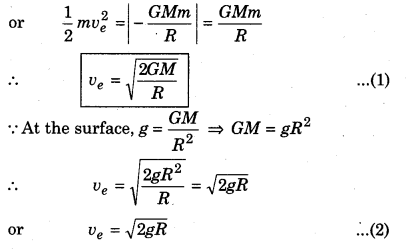
It is clear that escape velocity does not depend upon the mass of the object.
∵ g = 9.8m/s2 and R = 6.4 × 106 m
∴ Escape velocity from the surface of the Earth
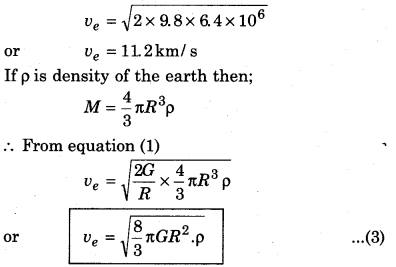
Escape velocity for any object at height h from the surface of the Earth at point

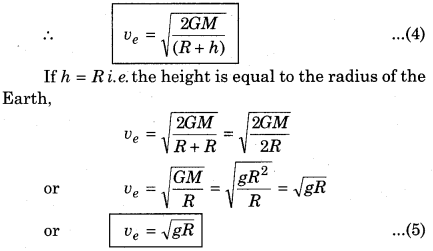
Keeping the values g= 9.8 m/s2 and R = 6.4 × 106 m in the above equation;
ve = \(\sqrt{9.8 \times 6.4 \times 10^{6}}\) = 7.92 km/s
In this situation the escape velocity will be equal to the orbital velocity of the satellite revolving close to the Earth.
Relation between Orbital Velocity and Escape Velocity
In the article (6.10.1) we will study that the orbital velocity of the satellite revolving close to the Earth is,
v0 = \(\sqrt{g R}\) …………. (1)
Escape velocity of the body at the surface of the Earth
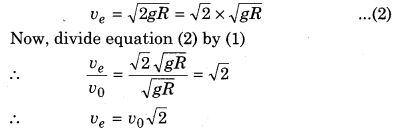
Hence, it is clear that if due to any reason the orbital velocity is done \(\sqrt{2}\) times, the satellite would escape from its orbit.
Question 4.
Derive relationship between g and G.
Answer:
Relation between Acceleration due to Gravity (g) and Universal Gravitational Constant (G)
The acceleration produced by the gravitational force of the Earth is called acceleration due to gravity (g)
“The acceleration gained by an object freely falling towards the Earth because of gravitational force is called acceleration due to gravity.”
It is represented by ‘ g’. This value is independent of the shape and mass of the body. Its S.I. unit is m/s2.
Suppose, that the Earth’s radius is R and its mass is M. The value of the gravitational force acting on a particle of mass ‘ m’ at a distance ‘ r’ from the center;
F = \(\frac{G M m}{r^{2}}\) ……………. (1)
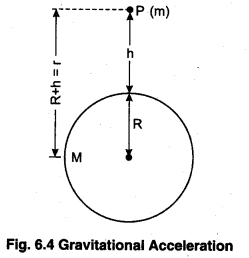
By, Newton’s second law of motion
F = ma
∴ If the acceleration due to gravity is g at point P
F = mg ………………. (2)
from the equation (1) and (2) we get
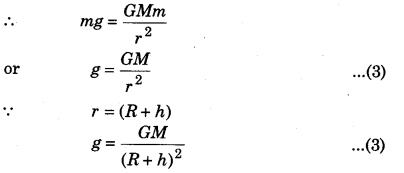
Where, ‘ h’ is the height of the particle above the Earth’s surface. If point P is close to the surface of the Earth then the value of h will be negligible with reference to the radius R of the Earth, i.e.
h << R’;
∴ h + R ≈ R
from the equation (3)
∴ g = \(\frac{G M}{R^{2}}\) ………….. (4)
If Earth’s average density is ρ then;
Mass of the Earth, M = Volume × Density
M = \(\frac{4}{3}\) πR3ρ
∴ From the equation (4)
g = \(\frac{G \frac{4}{3} \pi R^{3} \rho}{R^{2}}\)
or g = \(\frac{4}{3}\) πGRρ ……………… (5)
This equation (5) shows the relationship between (g) and density (ρ).
Question 5.
Prove that a satellite revolving close to the Earth’s surface has orbital velocity approximately 8 km/s.
Answer:
Orbital Velocity of a Satellite
The velocity of object by which is revolving in the orbit, is called orbital velocity.
Suppose a satellite of mass M is revolving around the Earth (mass M) at a distance h from the surface of earth with orbital velocity v0. The radius of the orbit of the satellite; r = (R + h)
The gravitational force between the satellite and the Earth provides the necessary centripetal force.
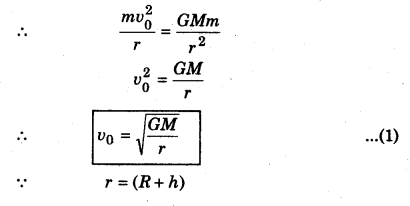
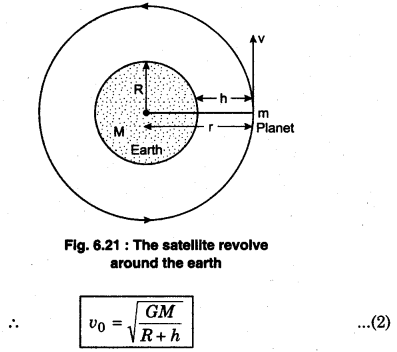
∵ Acceleration due to gravity at the surface of the Earth
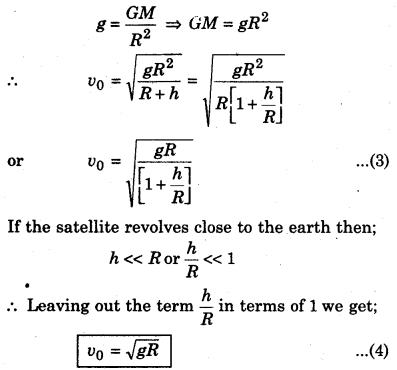
Question 6.
Calculate the height of Geo-stationary satellite above the Earth’s surface. How can it be used for communication?
Answer:
Geo-stationary Satellite
A satellite placed at a definite height directly above the Earth’s equator and revolves in the same direction as the Earth rotates; so that its orbital time period is same as the Earth’s rotation period (24 hours), is called a Geo-stationary satellite. The observer at the equator views the satellite as stationary, hence such types of satellites are also called geo-synchronous satellites. These are used for communication, radio broadcasting, universe related studies & researches and gathering weather information. Communication satellite is also a Geo-stationary satellite.
We know the time period of a satellite,
T = \(\frac{2 \pi r^{3 / 2}}{\sqrt{G M}}\)
∴ r = \(\left[\frac{G M T^{2}}{4 \pi^{2}}\right]^{1 / 3}\) ……………. (1)
Putting G = 6.67 × 10-11 Nm2/kg2, mass of Earth M = 6 × 1024 kg, time period T = 24 hours in above equation.
Orbital radius of the satellite from the equation (1) by putting all values;
r = 4.2 × 104 = 42000 km
but r = R + h
Hence, height of the satellite from the surface of the Earth;
h = r – R
h = 42000 km – 6400 km
or h ≈ 36000 km
Hence, the height of a geo-stationary satellite from the Earth’s surface is approximately 36000 km.
Angular Velocity of Geo-stationary Satellite
Since, angular velocity ω = \(\frac{2 \pi}{T}=\frac{2 \times 3.14}{24 \times 60 \times 60}\)
ω = 7.3 × 10-5 rad/s
Orbital velocity v = ωr
∴ v = 3.1 km/s.
For communication system, a satellite transmits signals to only \(\frac{1}{3}\) part of the Earth. Hence, to broadcast information throughout the Earth minimum three satellites are necessary.
Any communication satellite (geo-stationary) can not be placed over India’s capital New Delhi because it will not be in equatorial line.
Question 7.
Give reasons for the change in the intensity of the gravitational field of the Earth with respect to;
(1) Height, (2) Depth, (3) Due to rotation of the Earth.
Answer:
Variation in Acceleration due to Gravity (g) with Height, Depth Shape of the Earth and Its Rotation
The variation in the value of (g) above the surface of earth : Assume that M is the mass of the Earth and R is the radius. Hence, acceleration due to gravity on the surface of the Earth;
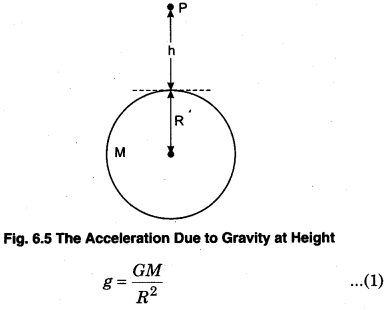
Value of acceleration due to gravity at point P at a height h above the Earth’s surface.
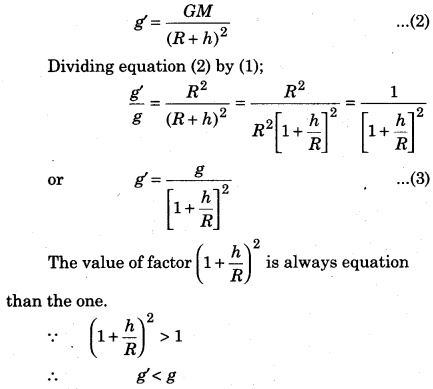
It is clear that as we move above the Earth’s surface, the value of g reduces.
From equation (3);
It is clear from the above the earth’s surface, the value of g reduces
g’ = \(g\left[1+\frac{h}{R}\right]^{-2}\)
If h << R then according to binomial theorem
[(1 + x)n = (1 + nx + ………. )] ≈ (1 + nx)
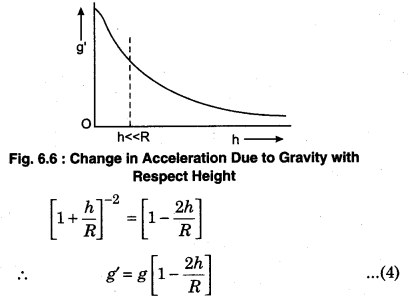
It is clear from the above figure that for h << R there would be a simple straight line change in the value of the acceleration due to gravity with h but for higher values of h it would be curved.
Percentage error in the variation of ‘g’
from equation (4)
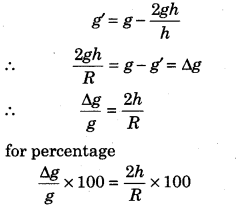
The variation in the value of g due to the shape of earth : In reality the shape of the Earth is not completely a sphere but it is flat at the poles. Assuming that Re and Rp are the equatorial radius and the polar radius respectively. Then, it is clear from the figure 6.9(a) that;
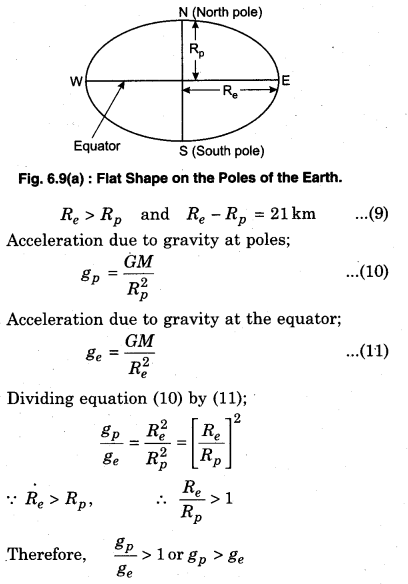
It is clear that acceleration due to gravity at poles is greater than acceleration due to gravity at the ’ equator. This means that on moving towards the poles from the equator, the value of acceleration due to gravity increases.
The variation in the value of ‘g’ due to the rotation of the Earth on its axis : Let R be the radius of the Earth and it is rotating on its axis with a definite angular velocity ω. Hence, it is clear that every object (body) on the surface of the Earth will move with the same constant angular velocity.
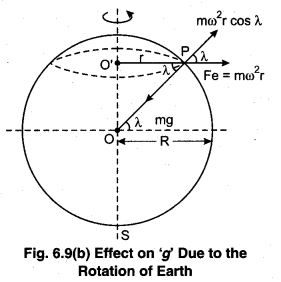
The necessary centripetal force required for this circular motion is obtained from the one component of the attraction force and the rest is obtained in the form of (mg’ )
Suppose that a particle of mass m is at a point P whose degree of latitude is λ . If there is no rotation of the Earth and the acceleration due to gravity is g then the weight of the particle (body) at P,
mg’ = mg – mrω2 cos λ
or g’ = g – rω2 cosλ,
∴ From ΔOPO’
\(\frac{r}{R}\) = cos λ ⇒ r = R cos λ
∴ From equation (12);
g’ = g – Rω2 cos2 λ
Question 8.
Define gravitational potential energy. Calculate the change in the potential energy in sending a particle to height h from the Earth’s surface. When h << R discuss about the changes in potential energy.
Answer:
Gravitational Potential Energy
The gravitational potential energy is equal to the amount of work done to bringing a mass from infinity to a point inside the gravitational field without any acceleration. It is a scalar quantity. It is always negative and consider to be zero at infinity.
Suppose, M is the mass of the Earth and R is the radius. A point T is at a height h above the Earth’s surface. The gravitational potential energy at this point is to be calculated for a body of mass M. For this we will have to calculate the work done to bringing the object from infinity to the point T. To calculate this in the direction OT there is another point S at a distance x from the center. The value of applied force on the body mass m;
F = \(\frac{G M m}{x^{2}}\)
Work done in displacing a body by dx in the direction of the force
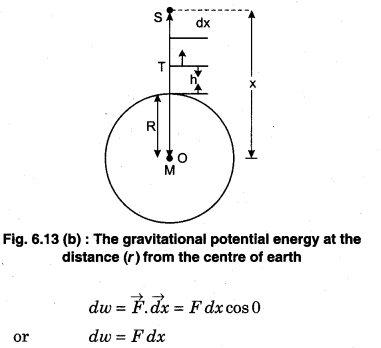
The distance of T from the centre of the Earth r = (R + h)
Hence, work done to bringing the body from infinity to point T or the gravitational potential energy of the body at T;
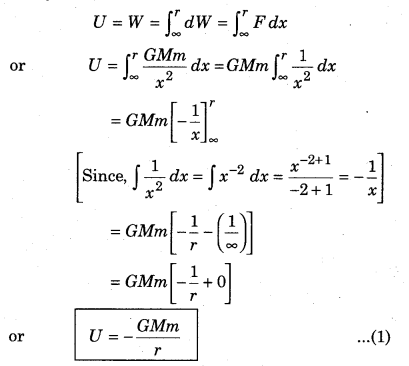
Situation 1 : For the surface of the Earth, h = 0,
∴ r = R
∴ U = \(\frac{-G M}{R}\) ………….. (2)
Situation 2 : Work done in taking the object to a height h above the Earth surface will be equal to the change in potential energy i. e.:
ΔU = W
∴ W = ΔU = U2 – U1
ΔU = Potential energy at height h – Potential energy at Earth’s surface
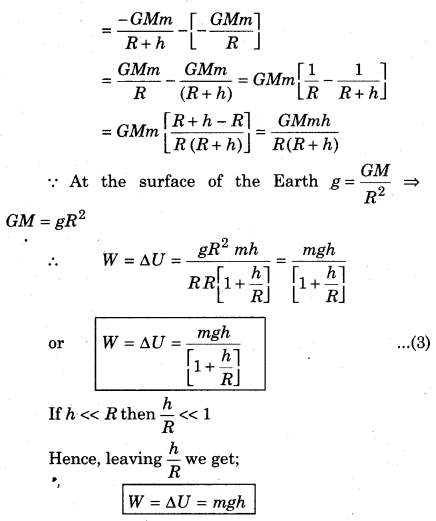
Question 9.
Explain Kepler’s laws.
Answer:
Kepler (1571-1630) studied the researches of Tycho Brahe for many years and gave the following three laws :
First Law or Law of Orbit : Every planet revolves around the Sun in elliptical orbit and with the Sun at one of the focus.
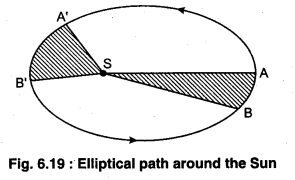
Second Law or Law of Area’s: An imaginary line drawn from the centre of the Sun to the centre of the planet will sweep out equal areas in equal intervals of time.
Suppose, a planet covers dA area in dt time, areal speed \(\frac{d A}{d t}\) = constant. As shown in the figure (6.19) the time taken by the planet to cover the distance from B to A is same as the time taken to cover the distance from B’ to A’. Hence, area SAB= area SA’ B’. Since, both the areas are same hence the orbital speed of the planet changes. When the planet moves away from the Sun, the speed decreases and when it comes closer it increases. Hence, writing areal speed in terms of angular momentum, the angular momentum of the moving planet remains constant; i.e; .
\(\frac{d A}{d t}=\frac{L}{2 m}\)
where L is angular momentum and m is the mass of the planet.
Third Law or law of periods : The ratio of the squares of the periods of any two planets is equal to the ratio of the cubes of their average distances from the Sun.
T2 ∝ r3
or T2 = Kr3
where K is a constant and r is the average distance between the planet and the Sun.
Therefore, it is clear that farther the planet from the Sun its time period will be more. This is the reason that the time period of Mercury is very less and that of Neptune maximum.
Question 10.
Explain weightlessness in space.
Answer:
The weight of an object (or body) is felt due to the attraction force acting on it. If the attraction force is zero then the state of weightlessness is felt. For example, if a person jumps freely downwards, then there is no attraction force applied to the person. Hence, weightlessness is felt.
In artificial satellites the objects are in a state of weightlessness. This truth can be understood as follows :
Suppose the mass of the Earth is M and M’ is the mass of any satellite which is revolving with an orbital speed v0 in an orbit of radius r. The necessary centripetal force is obtained from the gravitational force.
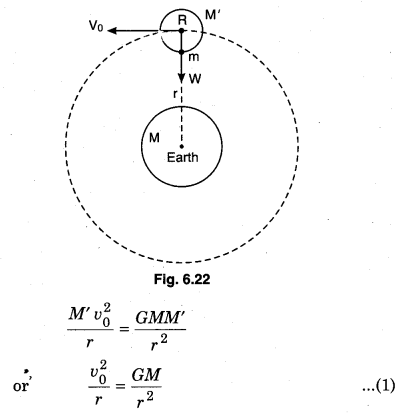
Suppose inside the satellite at its surface an object of mass m is kept on which the reaction force is R opposite in direction to its weight W. Hence, equation of motion of the object :
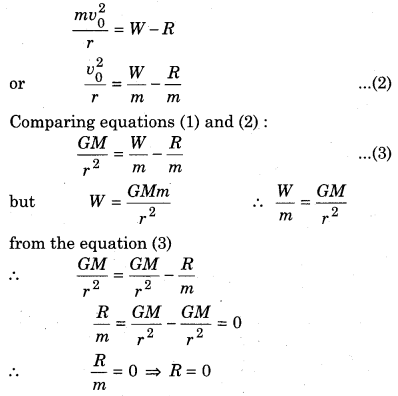
This means that the weight of the body is zero. In other words it can be said that in artificial satellites objects are in a state of weightlessness.
Question 11.
Derive formula for velocity of projection.
Answer:
Projection Velocity
The minimum velocity to throw an object vertically upwards to a definite height is called the projection velocity”.
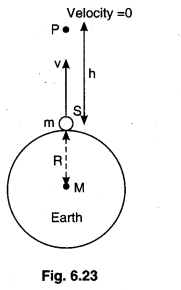
Suppose, if an object having mass (m) is projected with v velocity to a height (h) from the Earth’s surface, when the body is thrown upwards then the body’s kinetic energy is changed into its gravitational potential energy. Hence, from the law of conservation of energy :
Total energy of the body at the surface of the Earth (S) = Total energy of body at point P at height h
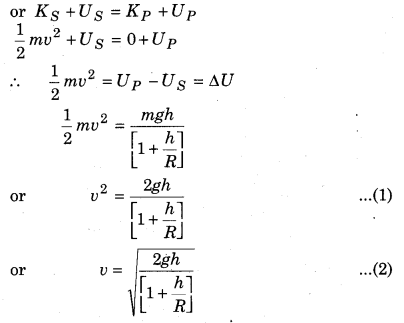
This is the formula for the projection velocity of a body going to a height h from the surface of the Earth.
The maximum height (h) gained by the object from equation (1) is;
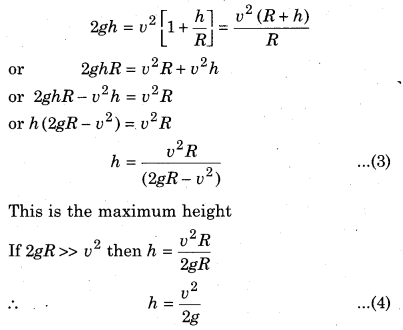
Question 12.
Write Newton’s gravitation law. Derive it in vector form an explain that it follows action-reaction law.
Answer:
Gravitational Law in Vector Form
As shown in the figure (6.3) the position vectors of particles M1 and M2 are \(\overrightarrow{r_{1}}\) and \(\overrightarrow{r_{2}}\) respectively.
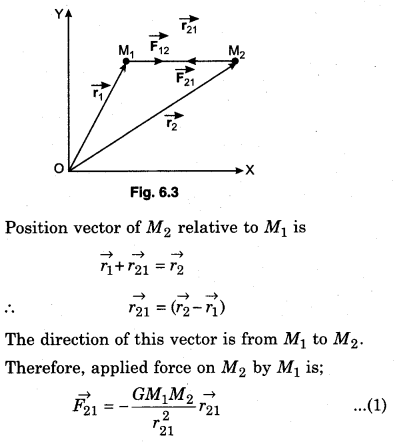
Negative sign tells about the attractive nature of force
Similarly force on M1 and M2
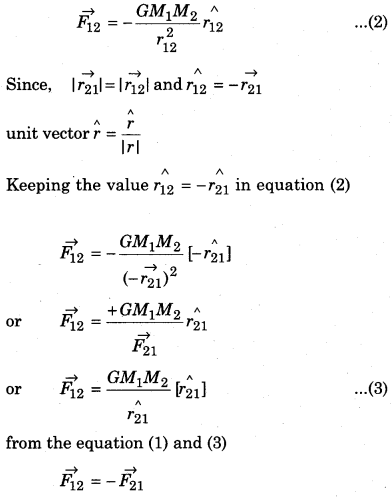
Hence, it is clear that the applied forces are equal and opposite. Hence, the gravitational force follows Newton’s third law.
RBSE Class 11 Physics Chapter 6 Numerical Questions
Question 1.
Calculate the gravitational force between two metal spheres of masses 50 kg and 100 kg respectively and the separation between their centres is 50 cm.
Solution:
Given; m1 = 50kg; m2 = 100kg;
r = 50cm = 50 × 10-2 m ; F = ?;
G = 6.67 × 10-11 Nm2kg-2
The magnitude of gravitational force,
F = \(G \frac{m_{1} m_{2}}{r^{2}}\)
= 6.67 × 10-11 × \(\frac{50 \times 100}{50 \times 50 \times 10^{-4}}\)
= 13.34 × 10-7 n
or F = 1.334 × 10-6N
Question 2.
If due to any reason, the orbital speed of a satellite increases 41.4%. Then in this situation would the satellite escape? Explain.
Solution:
Orbital velocity of the satellite = v0
When any hour, its orbital velocity is increases by 41.4% then the new value of orbital velocity
v’0 = v0 + \(\frac{41.4}{100} v_{0}=v_{0}\left[1+\frac{41.4}{100}\right]\)
= v0 [1 + 0.414] .
= v0 × 1.414 = v0\(\sqrt{2}\)
or v’0 = ve (escape velocity)
Therefore, the satellite will escape.
Question 3.
A body is thrown with a velocity of 10 km/s from the Earth’s surface, which is only a little less from the value of escape velocity. Calculate the height up to which the body will be reached.
Solution:
Maximum height achieved by the projectile,
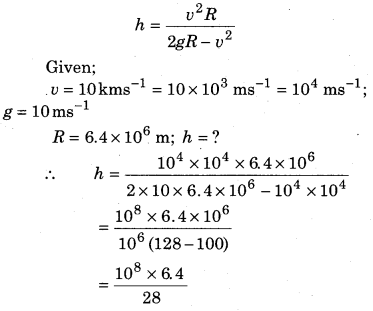
= 0.228 × 108
= 2.28 × 107 m
= 2.28 × 104 km
Question 4.
On the surface of the Earth a body’s weight is 72 N. How much would be the gravitational force at a height of half the radius of the Earth?
Solution:
Weight of a body on Earth’s surface, Ws = mg = 72N
or mg = 72N ………… (i)
Gravitational acceleration at height h,
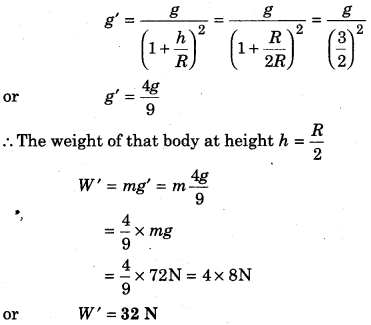
Question 5.
Escape velocity on the surface of the Earth is 11.2 km/s. If any object is thrown with double the escape velocity, what would be its speed at maximum distance? Neglect the presence of Sun and other celestial bodies.
Solution:
Escape velocity from the Earth’s surface,
ve = 11.2 km-s-1
Projection velocity from the Earth,
v1 = 2ve
∴ Kinetic energy of projection
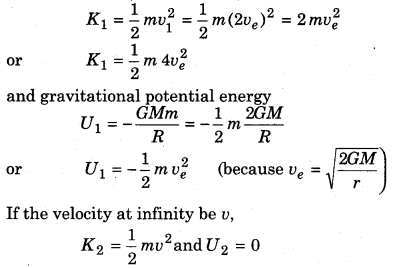
Now applying the principle” of conservation of energy,
Total energy on Earth’s surface = Total energy at infinity
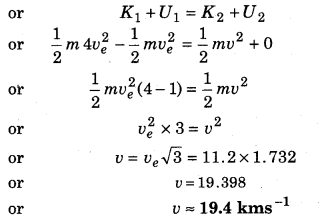
Question 6.
Three bodies of same masses are kept at the top of an equilateral triangle with side ‘ a’. What speed would the three bodies be moved in a circle so that the triangle moves in the circular orbit and there should be no change in the side of the triangle?
Solution:
The gravitational force acting between each couple of masses
F = \(\frac{G M M}{a^{2}}=\frac{G M^{2}}{a^{2}}\)
Each internal angle of equilateral triangle is of 60°. Therefore the resultant of forces acting on each mass will be directed towards the centre O of the circle and the same will the role of centripetal force for circular motion of the whole triangle.
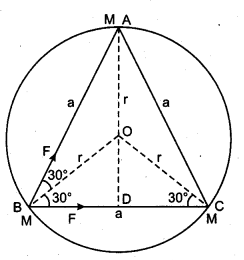
Centripetal force = Resultant force
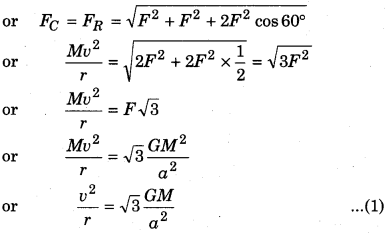
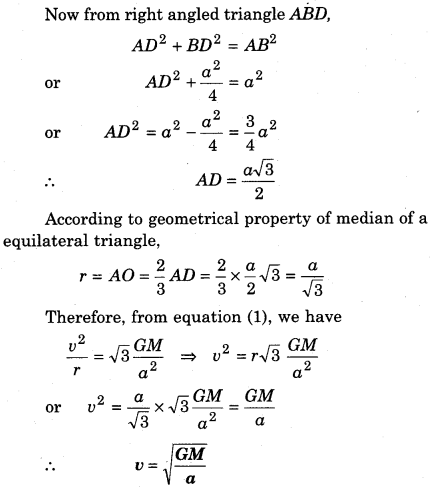
Question 7.
The potential energy of 3 kg body is -54 J. Calculate its escape velocity.
Solution:
Given; potential energy on the Earth’s surface Ui = – 54 J; mass of the body m = 3 kg
If the body escapes, then its potential energy at infinity Uf = 0
Escape energy = Uf – Ui = 0 – (-54) = 54J
or \(\frac{1}{2} m v_{e}^{2}\) = 54
or ve = \(\sqrt{\frac{2 \times 54}{m}}=\sqrt{\frac{2 \times 54}{3}}=\sqrt{36}\)
or ve = 6 ms-1
Question 8.
At how much height above the Earth’s surface, the value of gravitational acceleration would be 10% less than that on the surface?
Solution:
The gravitational acceleration at height h from the Earth’s surface,
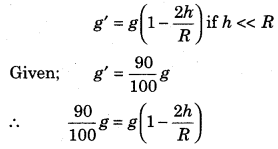
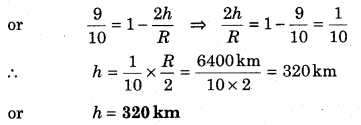
Question 9.
‘Lagrangian Point’ is a location in space between the Earth and the Sun; where the net gravitational force on any body due to both the Earth and the Sun is zero. Calculate the distance of this point from Earth. The distance between Earth and Sun is approximately 108 km, and the mass of the Sun is 3.24 × 105 times the mass of the Earth.
Solution:
Given; distance between Earth and Sun,
r = 108 km = 1011 m
Mass of Sun, Ms = 3.24 × 105Me
The distance of Lagrangian Point from the Earth x =?
A Lagrangian point P,
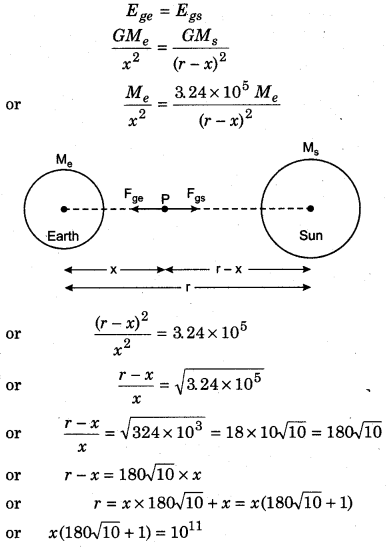
or x (568.8 + 1) = 1011
or x × 569.8 = 1011
∴ x = \(\frac{10^{11}}{569.8}=\frac{1000}{569.8} \times 10^{8}\)
or x = 1.75 × 108 m
Question 10.
Assume that any object is revolving around a big star in a circular orbit of radius R. Its time period is T. If the gravitational force between the object and the star is directly proportional to (R-5/2) then how is its time period dependent on radius?
Solution:
If the mass of the object and the star be m and M respectively, then according to question,
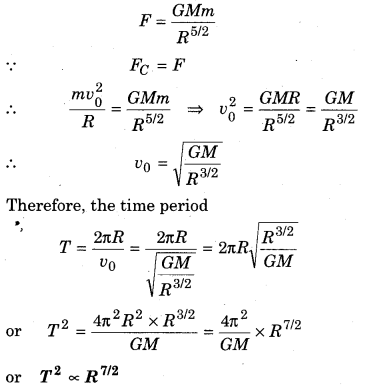
Question 11.
Calculate the escape velocity on the Moon. Given Earth’s radius is 4 times the radius of Moon and mass of Earth is 80 times of the Moon.
Solution:
Given Me = 80 Mm; Re = 4 Rm
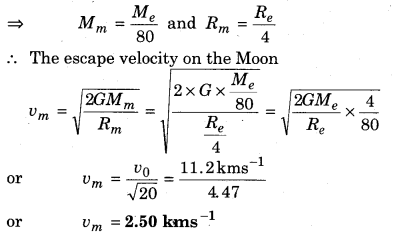
Question 12.
A space laboratory whose mass is 2 × 103 kg is transferred from an orbit of radius 2R to .an orbit of radius 31?. Calculate the work done. Here, R = 6400 km (Earth’s radius).
Solution:
Mass of Earth = M; mass of laboratory m = 2 × 103 kg;
r1 = 2R; r2 = 3R?; W = ?;
R = 6400km = 6.4 × 1036 m
The work done in transferring the laboratory
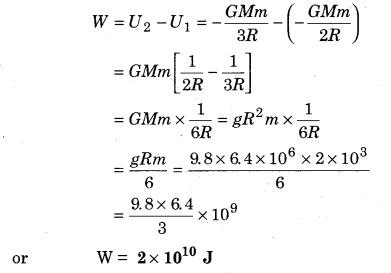
Question 13.
If radius of the Earth is 6400 km. Then what would be the linear velocity of any object at the equator?
Solution:
R = 6400 km; Time period of Earth’s rotation T = 24 hr
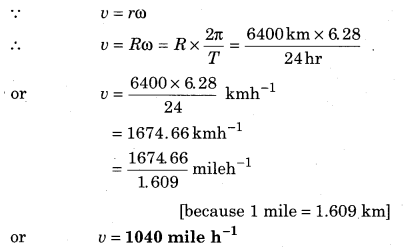
Question 14.
How much would be the increase in the potential energy if a body of mass m is taken to a height R equal to the radius of the Earth?
Solution:
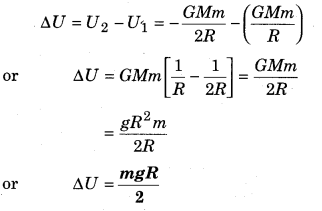
Question 15.
A satellite is revolving at a distance x from the centre of the Earth. How much would be the increase in its speed if the radius of the circular orbit reduces by 1%?
Solution:
Orbital speed of the satellite,
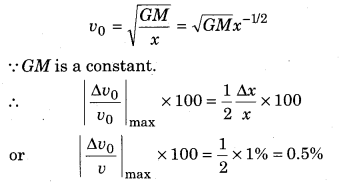
∴ The percentage increase in orbital velocity = 0.5%
Question 16.
How much would be the radius of the Sun so that it becomes a Black Hole? Take the mass of the Sun constant (1030 kg) and the maximum limit of velocity of projection should be equal to speed of the light because as given by Einstein the velocity of any object cannot be more than the speed of high.
’’ Hint: Black Hole are those celestial bodies from which no object can escape because their gravitational acceleration is very much.]
Solution:
Given; mass of the Sun M = 1030 kg
G = 6.67 × 1011 Nm2 kg-2
vmax = 3 × 108 ms-1; Rmin =?
Gravitational potential energy on the surface of the Sun
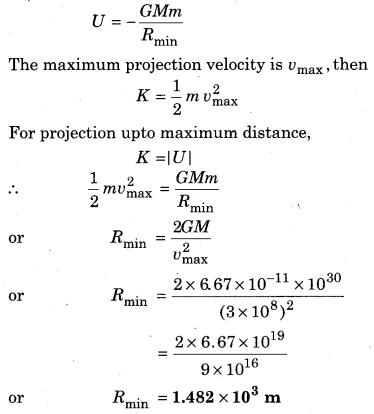
Question 17.
If an object is placed in a tunnel running through the Earth’s centre, it does simple harmonic motion. Calculate the time period for this. If radius of Earth is 6.4 × 106 m and mass is 6 × 1024 kg.
Solution:
Time period of simple harmonic motion of an object placed on the tunnel running through the centre of the Earth,
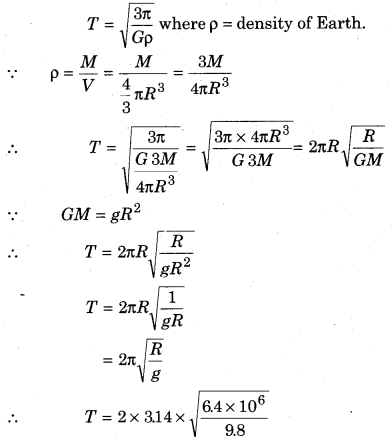
or T = 84.7 min = 85 min
Question 18.
What would be the change in escape velocity, if the radius of the Earth reduces 4% and mass remains constant?
Solution:
Escape velocity,
ve = \(\sqrt{\frac{2 G M}{R}}=\sqrt{2 G M} R^{-\frac{1}{2}}\)
From this formula, it is clear that on decreasing the value of Re escape velocity ve will increase.
∴ For maximum percentage error in ve
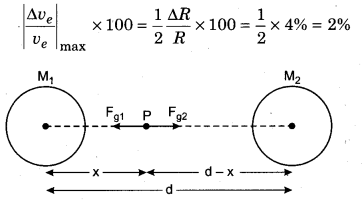
∴ Percentage increase in escape velocity = 2%
Question 19.
Two bodies of masses M1 and M2 are kept at a distance d from each other. Prove that the point at which the intensity of the gravitational field is zero, the gravitational potential will be :
V = \(\frac{-G}{d}\left[M_{1}+M_{2}+2 \sqrt{M_{1} M_{2}}\right]\)
Solution:
Suppose the intensity of gravitational field intensity at point P is zero. Therefore, the gravitational field intensity is a vector quantity. So,
